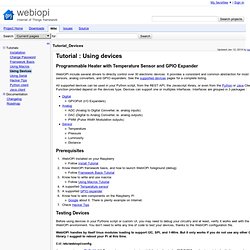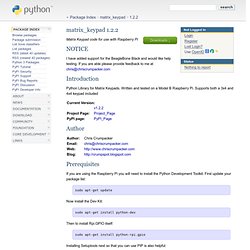

inventwithpython.com/cipherwheel/ Tutorial_Devices - webiopi - Internet of Things framework. Programmable Heater with Temperature Sensor and GPIO Expander WebIOPi include several drivers to directly control over 30 electronic devices.

It provides a consistent and common abstraction for most used sensors, analog converters, and GPIO expanders. See the supported devices pages for a complete listing. All supported devices can be used in your Python script, from the REST API, the Javascript library, or even from the Python or Java Client. Function provided depend on the devices type. Digital GPIOPort (I/O Expanders) Analog ADC (Analog to Digital Converter, ie. analog inputs) DAC (Digital to Analog Converter, ie. analog outputs) PWM (Pulse Width Modulation outputs) Sensor Temperature Pressure Luminosity Distance Prerequisites Testing Devices Before using devices in your Pythons script or custom UI, you may need to debug your circuitry and at least, verify it works well with the WebIOPi environment. WebIOPi handles by itself linux modules loading to support I2C, SPI, and 1-Wire. <!
<! Tutorial_Devices - webiopi - Internet of Things framework. Tutorial: Raspberry Pi GPIO Pins and Python. The GPIO pins on a Raspberry Pi are a great way to interface physical devices like buttons and LEDs with the little Linux processor.

If you’re a Python developer, there’s a sweet library called RPi.GPIO that handles interfacing with the pins. In just three lines of code, you can get an LED blinking on one of the GPIO pins. Not sure if Raspberry Pi is right for you? Make:’s interactive Board Guide lets you dial into the field to find the best board for your needs. Installation The newest version of Raspbian has the RPi.GPIO library pre-installed. Using the RPi.GPIO Library Now that you’ve got the package installed and updated, let’s take a look at some of the functions that come with it. Sudo python myInputSketch.py All of the following code can be added to this same file.
To add the GPIO library to a Python sketch, you must first import it: import RPi.GPIO as GPIO Then we need to declare the type of numbering system we’re going to use for our pins: from Meltwater’s Raspberry Pi Hardware. Keypad Matrix Python Package. Wiring Pi. Raspberry Pi GPIO Pinout. Matrix_keypad 1.2.2. Matrix Keypad code for use with Raspberry Pi I have added support for the BeagleBone Black and would like help testing.

If you are able please provide feedback to me at chris@chriscrumpacker.com Python Library for Matrix Keypads. Written and tested on a Model B Raspberry Pi. Supports both a 3x4 and 4x4 keypad included If you are using the Raspberry Pi you will need to install the Python Development Toolkit. Sudo apt-get update Now install the Dev Kit: Any m-by-n Matrix Keypad for Raspberry Pi. How to use WiringPi2 for Python on the Raspberry Pi in Raspbian part 1. What is WiringPi2 and why do I need it?

WiringPi2 for Python is an excellent GPIO handling system written by Gordon ‘Drogon’ Henderson and packaged for Python by Phil ‘Gadgetoid’ Howard. It uses Arduino-like scripting language. For simple GPIO work, I still tend to use RPi.GPIO because that’s what I first got started with, but WiringPi is a very good alternative. It currently has more features. One of the reasons (I think) the take-up for WiringPi-Python has been a bit slow, despite its richer feature set, is the lack of documentation.
If you’ve used my Gertboard Python software, you may well have used both the original WiringPi AND RPi.GPIO. All the basic features still work the same way, but Gordon has added a lot more capabilities. WiringPi2 is written in C, but has been packaged for Python, Ruby and PERL as well. WiringPi2 for Python is not installed in the standard Raspbian image, so you will have to install it before you can use it. So, once installed, how do you use it?
www.ece.uci.edu/~jhahn/python/DTMF.pyc. www.ece.uci.edu/~jhahn/python/DTMF.pyc.